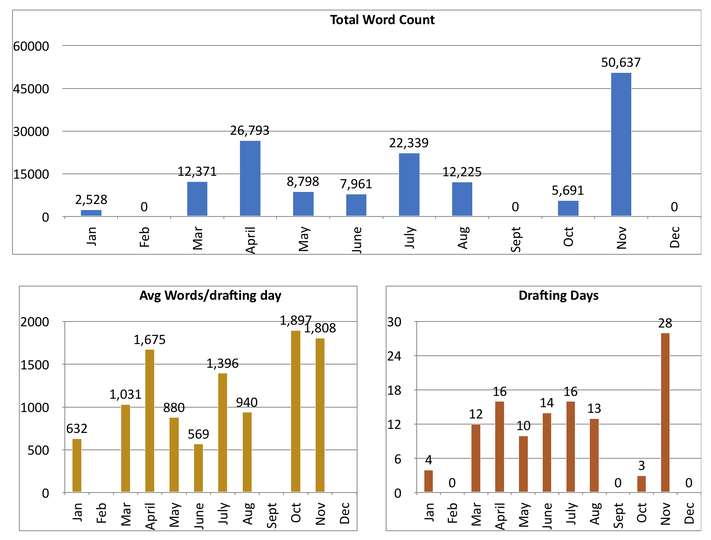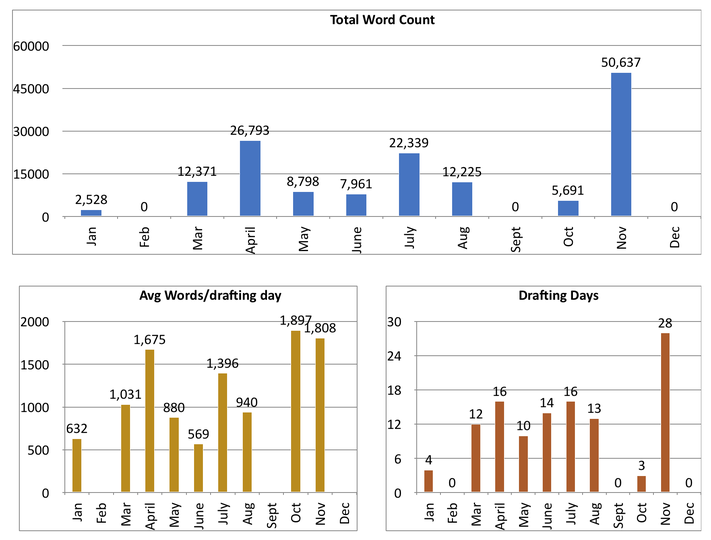NaNoWriMo 2017 After Action Report

I wanted to record for posterity my first experience of "winning" National Novel Writing Month. As you may know, NaNoWriMo is a self-challenge to write 50,000 words in 30 days.
Throughout 2017, I have been tracking my writing statistics (screenshot provided). As you may see from the screenshot, before November, I never got anywhere near 50k words in a single month. So I took NaNoWriMo 2017 as a true challenge to get my word counts up and make some real progress, to prove to myself that I could truly improve both speed and quality.

Background: The Story So Far
The novel I worked on in November 2017 was not my first. I started a novel back in November 2014, but did not win NaNo, or even come close. What I learned from that experience is that drafting a novel (what most people call "writing") takes preparation. I needed to know my characters, and my plot, better, or else I would spend all my writing time noodling around, doing "research" on the Internet (read "following Wikipedia links for hours"), and doing almost anything except actually producing publishable words on the page.
After struggling with that book for two years, I decided I needed a break. Not a break from writing, but a break from that particular book. The style and subject I had chosen for that book made it a very time-consuming task, and I wasn’t accelerating. I knew I needed to accelerate if I was ever going to reach my final production goal of producing four books a year.
So in 2017, I changed tacks. I also changed projects, and characters, and genres, and writing styles. Most importantly, I changed my focus. I put aside all my other optional projects so I could focus on writing.
If you look at my word count charts, they illustrate the story. In January, I wrote a scene. I had just read Farewell My Lovely by Raymond Chandler (if you listen to audio books, this one should not be missed), and I wanted to experiment with writing in that style. First person, but without internal monologues. Filled with over-the-top, sometimes hilarious metaphors and similes. Varied sentence length that leaned heavily to the short side. Characters that were hard, and dark, and mysterious.
So, I wrote a scene, off the top of my head, focusing on the style and letting the content be just whatever popped into my head. Didn’t matter if it made sense.
Long story -> short, I liked the output, and wanted to do more. But I now had this scene, and these characters, and all these little hints in the scene about secrets, and I didn’t know where any of it went! After that scene, I understand the thrill that "pantsers" have when they are writing. (And after working on the full project, I understand why I will never be a pantser.)
That gap in drafting in February is partially time I spent trying to flesh out the world, the characters, and the story that was born in that first scene. (And partially that I had no time to write because I just moved into a house while it was still under remodel, and it was cold, and the heat wasn’t working yet. Sigh.)
In March, I had produced an outline, I had a draft target of 55,000 words, and I was ready to go. I also decided to be meticulous about tracking my writing progress, because I’m a big nerd. My naive goal was to produce an average of 1,000 publishable words each day. Still not there. But getting better.
Through March, April, and May, I worked on my first draft. As you can see from the chart, April was the stand-out month for me. I had 16 writing days, and my per-day average was far higher than before. That’s because I created (what I thought was) a solid outline of the book before I started drafting. I knew where the story was going, so each day when I sat down, I knew exactly what I needed to work on. And, check it: I finished the book! Woohoo!
Lessons learned from the first completed book:
- The draft came in about 20% shorter than I had planned. Apparently I am a "short writer". Revisions need to add words more than remove them. That’s cool. Good to know.
- There was a point in the middle where the outline fell apart. I had to stop drafting and start outlining again. I would need more-detailed outlines in future.
I spent the rest of May and most of June revising and adding to the book. That’s why the word counts per day are much lower there. I was doing as much reading as writing, and I was padding out and enhancing scenes rather than writing them from whole cloth.
In June, I spent a couple of weeks outlining a sequel. In July I commenced drafting the sequel. July and August were good months for drafting. At the end of July, I looked back at my stats. I found that my words per day were pretty solid, but I wasn’t hitting my desired average over time, because I was not getting enough drafting days in. So I decided that, in August, I would focus on writing every single day, and not care so much about word count. I did really well on that for the first thirteen days of the month.
And then my outline blew up again. So I stopped writing, and went back to the drawing board to figure out what to write.
The Run-up to NaNoWriMo
By the time I had that outline fixed, I realized that I only had a couple of months to go before NaNo. I was determined to win NaNo this year with what I learned. I knew to win, I needed to have a really thorough outline. I knew my timing would be off if I continued with the current project, so I shelved it. (Sorry Tracy! I will finish it, I promise!)
I started researching for my epic fantasy series. (How do you research fantasy? More about that in a future post.) Then, I started building an outline. I built it first using the same basic process as before, just make a card for each event. But I had learned that an event is not necessarily a scene or a chapter. Sometimes, it’s just a page, or a sentence. So then I went back, and started stacking those events. New Stuff:
I made a list of POV characters and assigned scenes to them.
I reshuffled the outline to get thematic alignment between the story threads.
I ran it through the Story Grid and Save the Cat frameworks to make sure I was hitting the right beats. I even looked at it through the lens of Dramatica (more on that in another post too). I added scenes and characters to bring it into alignment.
Once I had beaten the book outline into submission, I went back to the beginning and started outlining each individual scene, making sure it had an inciting incident, a turning point, an emotional charge, and as much as possible, a dramatic conflict.
Three days before November began, I could see that I was not going to finish my individual scene outlines in time. I had 42 of them to do, and each one was taking about an hour. I decided I would create them as I went along.
Since my outline called for an 82,000 word draft, I decided to go ahead and start drafting.
Thirty Days of NaNoWriMo
The first few days, I was drafting scenes for which I had created scene outlines. This was so easy it felt like cheating. I already knew the emotional content, the character conflicts, the implications for future chapters. I blasted through my target word counts each day. The first day I missed target was the 7th, but that was because somebody broke into my house and tossed the place while I was at work, and I had to spend my writing time dealing with that. (Real life sucks.)
Couple of days later, my scene outlines ran out, and I had only single-paragraph descriptions to work from for each scene. Some of those scenes were already well-formed in my mind, and those days produced more than 2,000 words. Other scenes still needed the outline work put in, and on those days, I struggled. Even on the slow days, though, I was usually able to break at least 1,000 words.
For most of the month, I was well ahead of the target curve. But, life happens. I had a couple of days when I was too busy to write, and a couple that produced very few words, because of reasons. I was falling behind. But I was so close!
To make sure I caught up, I decided to switch from my linear approach (writing scenes in the order they would appear in the book) to a non-linear selection approach (writing scenes that had the strongest outlines, and connected more directly to scenes already written). In that way, I was able to power through that last weekend and get back on top. It took me until the final day of the month, but I did, finally, cross the 50k mark. I win!
November 2017 was my most productive month ever! I drafted on 28 of 30 days, and yet my average per day was higher than ever before! I attribute this to the intense work I put into outlining the book, and then the individual scenes, before the drafting phase began. For my next book, I will complete the scene-level outlines before I begin drafting.
As I write this, I still have about 25k words to write in the first draft of this book. And I can tell you, that first draft is rough. It’s going to need a lot of work. But it’s also clear to me that I am improving as I go. If I keep working, keep learning, keep accelerating, I will soon hit that thousand word a day goal. And may even produce a book worth publishing!